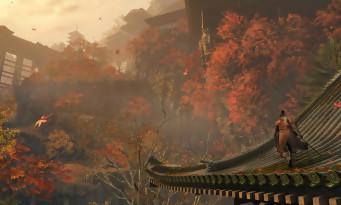 Maybe we're bad, maybe we don't have enough skill, but we took a lot more in Sekiro: Shadows Die Twice than in Dark Souls 3. No, Miyazaki-san and his flocks have not deviated from their line of conduct and continue to impose on the player a coolness, control and accuracy at all times. However, we were convinced that the removal of the endurance gauge would result in an open house operation for purists: with runs, dodges and attacks in unlimited flat rate mode, the challenge gave the impression of being killed in the world. 'egg. In fact, it now resides in the Posture bar that defines the very essence of Sekiro: Shadows Die Twice. But before discussing this mechanic in detail, let's dwell for a moment on Wolf, the hero of the game who places the code of honor of the shinobi above everything else. Responsible for ensuring the protection of a young heir, he will fail in his mission and, during his duel against Genichiro Ashina, have his left arm cut off. Returning from the realm of the dead, Wolf is given a prosthesis by a reclusive sculptor in a temple in ruins. The starting point for a second life imbued with dignity and respect, since each time a coup de grace is delivered to a general of the Ashina clan or to an old acquaintance, he will ask for forgiveness as if to make him understand that he does not had no choice; all in one last bloodshed. Honestly, it slaps, especially after a tough fight.
Maybe we're bad, maybe we don't have enough skill, but we took a lot more in Sekiro: Shadows Die Twice than in Dark Souls 3. No, Miyazaki-san and his flocks have not deviated from their line of conduct and continue to impose on the player a coolness, control and accuracy at all times. However, we were convinced that the removal of the endurance gauge would result in an open house operation for purists: with runs, dodges and attacks in unlimited flat rate mode, the challenge gave the impression of being killed in the world. 'egg. In fact, it now resides in the Posture bar that defines the very essence of Sekiro: Shadows Die Twice. But before discussing this mechanic in detail, let's dwell for a moment on Wolf, the hero of the game who places the code of honor of the shinobi above everything else. Responsible for ensuring the protection of a young heir, he will fail in his mission and, during his duel against Genichiro Ashina, have his left arm cut off. Returning from the realm of the dead, Wolf is given a prosthesis by a reclusive sculptor in a temple in ruins. The starting point for a second life imbued with dignity and respect, since each time a coup de grace is delivered to a general of the Ashina clan or to an old acquaintance, he will ask for forgiveness as if to make him understand that he does not had no choice; all in one last bloodshed. Honestly, it slaps, especially after a tough fight.
As ruthless as Dark Souls and Bloodborne, Sekiro: Shadows Die Twice once again demonstrates From Software's mastery of torture.
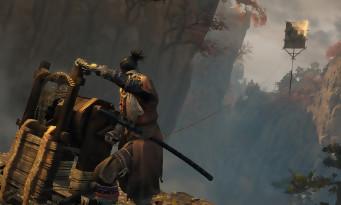 Unlike Dark Souls and Bloodborne, which asked us to choose our character from a selection of classes – whose stats varied from one to another – Sekiro: Shadows Die Twice, therefore, offers us to embody a well-identified ninja. It doesn't seem like much said like that, but this decision has an impact on several levels. In terms of narration first of all, because instead of scattering the plot to the four corners of the game through inscriptions and items that were once well hidden, the developers have relied this time on a certain number of story NPCs to create some sort of bond between them and the mercenary. Certainly, we find the fragmented style dear to Hidetaka Miyazaki, but where his old works were content with one or even two lines of text, the interlocutors are much more talkative in Sekiro: Shadows Die Twice. There are even answer choices sometimes, but the whole remains basic and illusory. In any case, it allows you to take advantage of a Wolf capable of expressing himself (including in the language of Molière, although we have opted for Japanese subtitled in French), which radically changes the way in which we perceive the protagonist that we control. The fact of embodying only one hero also influences the design of the adversaries. With a single profile to take into account, From Software has indeed been able to refine their patterns by raising the degree of intransigence: if their attacks are more readable than in the past, the slightest error is paid for in cash; and cash means three-quarters of the vital gauge jumping against an enraged boss. It becomes unbreathable at times, and the fans of the house will soon seek to boost the performance of the ninja so as not to bite the dust a billion times in the face of the same golgoth.
Unlike Dark Souls and Bloodborne, which asked us to choose our character from a selection of classes – whose stats varied from one to another – Sekiro: Shadows Die Twice, therefore, offers us to embody a well-identified ninja. It doesn't seem like much said like that, but this decision has an impact on several levels. In terms of narration first of all, because instead of scattering the plot to the four corners of the game through inscriptions and items that were once well hidden, the developers have relied this time on a certain number of story NPCs to create some sort of bond between them and the mercenary. Certainly, we find the fragmented style dear to Hidetaka Miyazaki, but where his old works were content with one or even two lines of text, the interlocutors are much more talkative in Sekiro: Shadows Die Twice. There are even answer choices sometimes, but the whole remains basic and illusory. In any case, it allows you to take advantage of a Wolf capable of expressing himself (including in the language of Molière, although we have opted for Japanese subtitled in French), which radically changes the way in which we perceive the protagonist that we control. The fact of embodying only one hero also influences the design of the adversaries. With a single profile to take into account, From Software has indeed been able to refine their patterns by raising the degree of intransigence: if their attacks are more readable than in the past, the slightest error is paid for in cash; and cash means three-quarters of the vital gauge jumping against an enraged boss. It becomes unbreathable at times, and the fans of the house will soon seek to boost the performance of the ninja so as not to bite the dust a billion times in the face of the same golgoth.
NO ARM…
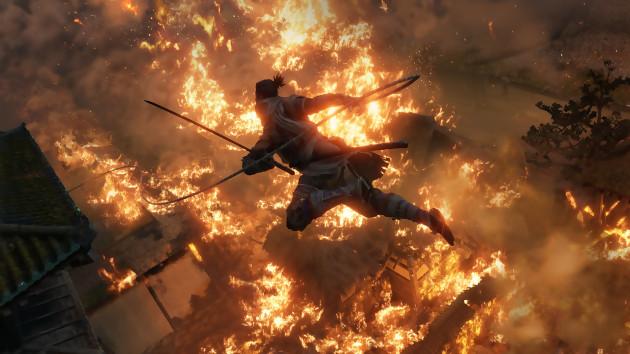 Precisely, the studio has also reviewed its copy in this area. Until now, the less gifted could compensate for their wooden reflexes by farming like crazy. Which has always been our case, by the way, and tirelessly redoing the same areas to gain strength, vitality, endurance, or even resistance, mechanically allowed us to gain the upper hand over enemies. In Sekiro: Shadows Die Twice, it's a bit more complicated. Basically, the experience points that we recover are no longer used to upgrade the characteristics of the character, but to scrape skill points; and thanks to these skill points, we have the possibility of unlocking new attacks as well as passive techniques. Of course, this all happens in the skill tree which is divided into three categories: Shinobi Arts, Prosthetic Arts, and Ashina Arts. The Shinobi Arts primarily focus on combat and stealth. The Prosthetic Arts, for their part, concern all the techniques that Wolf can perform with his sword arm. Finally, the Ashina Arts focus on the Ashina swordsmanship worked for ages by Isshin. As always with From Software, we have total freedom to develop our build, but there are still essentials. For example, we strongly recommend improving the effectiveness of healing items: not having to burn two gourds to fill the life bar, it's practical. Aerial deflection is also essential against opponents who tend to conclude their jumps with a blade strike. When you can anticipate the blows from the opposite side, increasing the damage inflicted by a counter Mikiri is perhaps not a bad idea.
Precisely, the studio has also reviewed its copy in this area. Until now, the less gifted could compensate for their wooden reflexes by farming like crazy. Which has always been our case, by the way, and tirelessly redoing the same areas to gain strength, vitality, endurance, or even resistance, mechanically allowed us to gain the upper hand over enemies. In Sekiro: Shadows Die Twice, it's a bit more complicated. Basically, the experience points that we recover are no longer used to upgrade the characteristics of the character, but to scrape skill points; and thanks to these skill points, we have the possibility of unlocking new attacks as well as passive techniques. Of course, this all happens in the skill tree which is divided into three categories: Shinobi Arts, Prosthetic Arts, and Ashina Arts. The Shinobi Arts primarily focus on combat and stealth. The Prosthetic Arts, for their part, concern all the techniques that Wolf can perform with his sword arm. Finally, the Ashina Arts focus on the Ashina swordsmanship worked for ages by Isshin. As always with From Software, we have total freedom to develop our build, but there are still essentials. For example, we strongly recommend improving the effectiveness of healing items: not having to burn two gourds to fill the life bar, it's practical. Aerial deflection is also essential against opponents who tend to conclude their jumps with a blade strike. When you can anticipate the blows from the opposite side, increasing the damage inflicted by a counter Mikiri is perhaps not a bad idea.
You will therefore have understood it, zoning while waiting for the fault is no longer authorized in Sekiro: Shadows Die Twice which forces you to constantly attack, even if it means sometimes taking reckless risks.
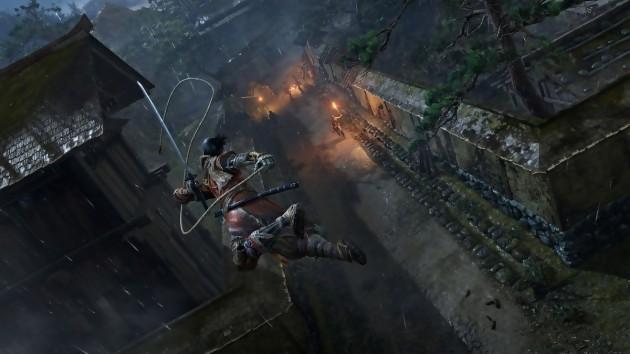 In short, even if the game does not drown us under a flood of parameters and loot (probably for accessibility issues), there is enough to decide Wolf's orientation. It is possible to rectify the situation along the way, but the efforts required to recover skill points will then be doubled; an immutable rule. It is better to target our needs from the start, therefore, so as not to have to clean, re-clean and re-clean levels that have already been explored. As for the hero's power, it is now attached to combat memories collected from the corpses of bosses. More clearly, it is only after having “consumed” a memory that our saber blows will hurt more. Rough, but you have to admit that the feeling of having gone to the end of yourself, of having fought with your guts, is all the greater. And then, remember that the prosthesis can also inflict welcome damage (provided you have enough spiritual emblems in stock) when you take the time to perfect it at the sculptor. We think not only of the different tools (umbrella, axe, spear, shuriken among others) that he can attach to his end, but also of all the improvements that come with them. On this subject, we will note that it will be imperative to find the appropriate items to unlock certain optimizations – in theory, we can miss it if we do not care to explore the surroundings – without forgetting the parts and the materials first to provide the forecastle. As for rosary beads, they are valuable for increasing the life gauge and the Posture bar. Again, you will have to go to the coal to get them since they will be in the hands of tough mid-bosses.
In short, even if the game does not drown us under a flood of parameters and loot (probably for accessibility issues), there is enough to decide Wolf's orientation. It is possible to rectify the situation along the way, but the efforts required to recover skill points will then be doubled; an immutable rule. It is better to target our needs from the start, therefore, so as not to have to clean, re-clean and re-clean levels that have already been explored. As for the hero's power, it is now attached to combat memories collected from the corpses of bosses. More clearly, it is only after having “consumed” a memory that our saber blows will hurt more. Rough, but you have to admit that the feeling of having gone to the end of yourself, of having fought with your guts, is all the greater. And then, remember that the prosthesis can also inflict welcome damage (provided you have enough spiritual emblems in stock) when you take the time to perfect it at the sculptor. We think not only of the different tools (umbrella, axe, spear, shuriken among others) that he can attach to his end, but also of all the improvements that come with them. On this subject, we will note that it will be imperative to find the appropriate items to unlock certain optimizations – in theory, we can miss it if we do not care to explore the surroundings – without forgetting the parts and the materials first to provide the forecastle. As for rosary beads, they are valuable for increasing the life gauge and the Posture bar. Again, you will have to go to the coal to get them since they will be in the hands of tough mid-bosses.
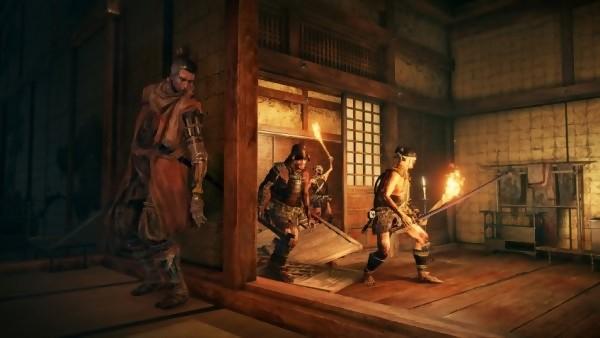 The Posture gauge is undeniably the key element of Sekiro: Shadows Die Twice. It's simple: once the latter is completely filled, you are exposed to a devastating attack, a punishment valid for both Wolf and his enemies. The Posture bar fills up no matter what; we must therefore do everything to slow down its progression and crack the opponent first. The most effective method consists in multiplying the counters, which implies a perfect knowledge of the patterns, a good dose of anticipation, and of course a science of timing. Being satisfied with a simple guard is not necessarily viable, because during boss fights (during which we must eliminate up to three life gauges), two or three big blows are enough to pulverize our Posture gauge. At the limit, we can draw the prosthesis and its umbrella with iron edges which, for once, acts as a solid shield without relieving the Posture bar. Chaining rolls or moving away from the enemy is not the idea of the century either, since it gives him the opportunity to redo the icing unless his life gauge is seriously started. In this case, his Posture bar will take a little longer to decrease. Afterwards, there are times when we still need to catch our breath and cool our Posture gauge. Too bad if it ruins all the efforts made so far, but it allows you to put your head back in place before returning to battle. From time to time, it happens that we don't even calculate what we are doing anymore, that we act only on instinct because in addition to classic blows, opponents are also able to slam attacks (preceded of a blood red kanji) that cannot be blocked or parried. Jumping while kicking to stay in the flow, or placing a counter against Mikiri, are the two recommended solutions in this case.
The Posture gauge is undeniably the key element of Sekiro: Shadows Die Twice. It's simple: once the latter is completely filled, you are exposed to a devastating attack, a punishment valid for both Wolf and his enemies. The Posture bar fills up no matter what; we must therefore do everything to slow down its progression and crack the opponent first. The most effective method consists in multiplying the counters, which implies a perfect knowledge of the patterns, a good dose of anticipation, and of course a science of timing. Being satisfied with a simple guard is not necessarily viable, because during boss fights (during which we must eliminate up to three life gauges), two or three big blows are enough to pulverize our Posture gauge. At the limit, we can draw the prosthesis and its umbrella with iron edges which, for once, acts as a solid shield without relieving the Posture bar. Chaining rolls or moving away from the enemy is not the idea of the century either, since it gives him the opportunity to redo the icing unless his life gauge is seriously started. In this case, his Posture bar will take a little longer to decrease. Afterwards, there are times when we still need to catch our breath and cool our Posture gauge. Too bad if it ruins all the efforts made so far, but it allows you to put your head back in place before returning to battle. From time to time, it happens that we don't even calculate what we are doing anymore, that we act only on instinct because in addition to classic blows, opponents are also able to slam attacks (preceded of a blood red kanji) that cannot be blocked or parried. Jumping while kicking to stay in the flow, or placing a counter against Mikiri, are the two recommended solutions in this case.
If followers of From Software thought that the game would be more docile than its predecessors, it is because of the resurrection which allows the hero to escape death.
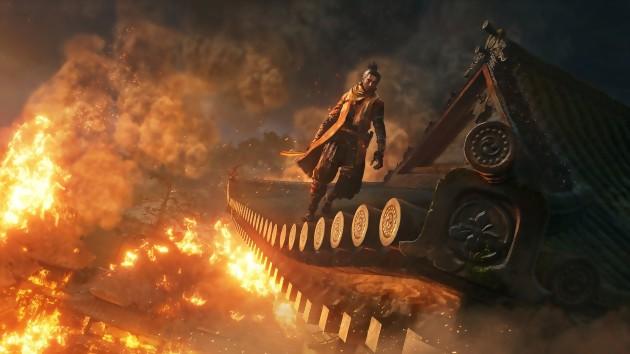 You will therefore have understood it, zoning while waiting for the fault is no longer authorized in Sekiro: Shadows Die Twice which forces you to constantly attack, even if it means sometimes taking reckless risks. A philosophy in perfect agreement with the time of the game where the guys must certainly try to cut through the bacon without asking the slightest question. If followers of From Software thought that the game would be more docile than its predecessors, it is because of the resurrection which allows the hero to temporarily escape death. With a simple press of the right trigger, we resume our march where it was supposed to stop, with opponents who also return to their initial position. We can therefore wait until the very last moment before being reborn from our ashes, and thus benefit from a few free executions. However, there is a limit to all this, that is to say that the resurrection power must be full to benefit from it, knowing that where we are, we have two spheres available. Does that mean you can resurrect twice in quick succession? No, From Software obliges. Even if our two spheres are full (by removing the enemies), there is a delay before we can activate the second resurrection. We let you imagine the stress during a boss fight. In any case, this feature makes it possible to join a little more serenely the following Idol of the Sculptor (the equivalent of the campfires of Dark Souls), purists being aware that dying in a From Software game amounts to losing everything one has accumulated since the last save point. Well, except in Sekiro: Shadows Die Twice which introduces the Divine Aid mechanic.
You will therefore have understood it, zoning while waiting for the fault is no longer authorized in Sekiro: Shadows Die Twice which forces you to constantly attack, even if it means sometimes taking reckless risks. A philosophy in perfect agreement with the time of the game where the guys must certainly try to cut through the bacon without asking the slightest question. If followers of From Software thought that the game would be more docile than its predecessors, it is because of the resurrection which allows the hero to temporarily escape death. With a simple press of the right trigger, we resume our march where it was supposed to stop, with opponents who also return to their initial position. We can therefore wait until the very last moment before being reborn from our ashes, and thus benefit from a few free executions. However, there is a limit to all this, that is to say that the resurrection power must be full to benefit from it, knowing that where we are, we have two spheres available. Does that mean you can resurrect twice in quick succession? No, From Software obliges. Even if our two spheres are full (by removing the enemies), there is a delay before we can activate the second resurrection. We let you imagine the stress during a boss fight. In any case, this feature makes it possible to join a little more serenely the following Idol of the Sculptor (the equivalent of the campfires of Dark Souls), purists being aware that dying in a From Software game amounts to losing everything one has accumulated since the last save point. Well, except in Sekiro: Shadows Die Twice which introduces the Divine Aid mechanic.
DISCREETLY
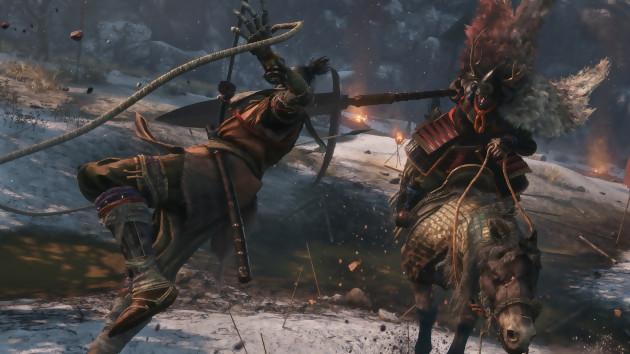 Thanks to it, we will be able to keep our loot intact (items, XP points, currency for example) formed between two checkpoints with, once again, a restriction dictated by Miyazaki-san and his teams. More concretely, this Divine Aid will be altered if Wolf does not take the time to heal – using drops of dragon's blood – the NPCs affected by the dragon plague. The more evil spreads in the kingdom, the less chance there will be of benefiting from Divine Help. Magnanimous, the developers have placed a percentage in the inventory to keep an eye on how often this boost is requested. Personally, we have already fallen to 4%. Without Divine Aid, each failure takes half the money and experience points earned. Fortunately, once a skill level is crossed, it is definitely acquired. It's no coincidence that Sekiro: Shadows Die Twice is often compared to Tenchu. Not only do they share the same universe, but they also have the same taste for infiltration. However, don't expect anything as oily as the competition; we clearly feel that this is not an art in which From Software excels. The studio has made a point of taking up the basics of the genre such as following a wall, hiding in the tall grass, or even clinging to the edges to enter incognito in well-monitored areas. It is true that there is something to have fun. The problem is that it still lacks consistency. OK, we can nab a guard while hanging above the ground, we can also swoop down on him while passing through the air, or even kill him with one shot while being stuck against a wall.
Thanks to it, we will be able to keep our loot intact (items, XP points, currency for example) formed between two checkpoints with, once again, a restriction dictated by Miyazaki-san and his teams. More concretely, this Divine Aid will be altered if Wolf does not take the time to heal – using drops of dragon's blood – the NPCs affected by the dragon plague. The more evil spreads in the kingdom, the less chance there will be of benefiting from Divine Help. Magnanimous, the developers have placed a percentage in the inventory to keep an eye on how often this boost is requested. Personally, we have already fallen to 4%. Without Divine Aid, each failure takes half the money and experience points earned. Fortunately, once a skill level is crossed, it is definitely acquired. It's no coincidence that Sekiro: Shadows Die Twice is often compared to Tenchu. Not only do they share the same universe, but they also have the same taste for infiltration. However, don't expect anything as oily as the competition; we clearly feel that this is not an art in which From Software excels. The studio has made a point of taking up the basics of the genre such as following a wall, hiding in the tall grass, or even clinging to the edges to enter incognito in well-monitored areas. It is true that there is something to have fun. The problem is that it still lacks consistency. OK, we can nab a guard while hanging above the ground, we can also swoop down on him while passing through the air, or even kill him with one shot while being stuck against a wall.
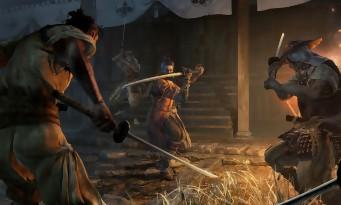 On the other hand, we did not understand why, being stashed in a bush, we could not discreetly remove a soldier arriving from the front. Systematically, we get spotted. To attract the attention of an enemy, we are told that we can swing porcelain. Why not. In the end, the result is flawed: not only are the guards unable to hear an object break in dead silence, but in addition they have to be targeted directly for them to react. It's just incomprehensible, and yet we spent time trying to identify a logic that escaped us, perhaps. In vain. In this exercise, the AI displays its limits with enemies who remain motionless when we have just cut the throat of their comrade two meters away. Even the patrols are not crazy: if there is a suspicion of intrusion (materialized by a yellow icon), the guard will take a quick look before returning to his post. It contrasts diametrically with the dynamic confrontations of the game. It's a shame, because the level design of Sekiro: Shadows Die Twice lends itself perfectly to infiltration. By taking the time, you can very well clean entire sectors without ending up with the whole pack on your back. We thought that not being able to use the grappling hook anywhere was going to be painful, but it's not. The attachment points are numerous enough to exploit the verticality of the environments without any problem.
On the other hand, we did not understand why, being stashed in a bush, we could not discreetly remove a soldier arriving from the front. Systematically, we get spotted. To attract the attention of an enemy, we are told that we can swing porcelain. Why not. In the end, the result is flawed: not only are the guards unable to hear an object break in dead silence, but in addition they have to be targeted directly for them to react. It's just incomprehensible, and yet we spent time trying to identify a logic that escaped us, perhaps. In vain. In this exercise, the AI displays its limits with enemies who remain motionless when we have just cut the throat of their comrade two meters away. Even the patrols are not crazy: if there is a suspicion of intrusion (materialized by a yellow icon), the guard will take a quick look before returning to his post. It contrasts diametrically with the dynamic confrontations of the game. It's a shame, because the level design of Sekiro: Shadows Die Twice lends itself perfectly to infiltration. By taking the time, you can very well clean entire sectors without ending up with the whole pack on your back. We thought that not being able to use the grappling hook anywhere was going to be painful, but it's not. The attachment points are numerous enough to exploit the verticality of the environments without any problem.
We feared, however, that the association with Activision would prevent the studio from giving its full potential, but our clenched fist and the sweat poured out at each boss fight attest to the sometimes suffocating challenge that we had to overcome.
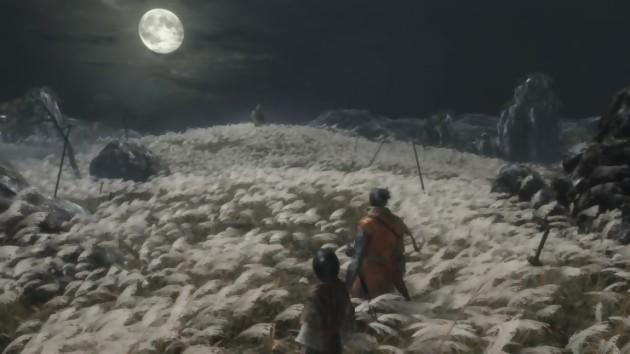 What is a little more annoying, however, is the camera which no longer manages to follow when the blows of the blade and the ripostes start to go in all directions, especially in tight places. More than once we had to reset the lock, because it had oddly deactivated after we got locked in a corner. We are then forced to break free, to refocus on the opponent, and to return to combat after having stupidly lost a good part of our vital gauge. If the liveliness of the game is exhilarating, the camera remains largely perfectible. Of course, From Software didn't just do new things and also took over what worked in its previous productions. It is therefore impossible not to think of the Fireliga sanctuary (Dark Souls) and the Hunter's Dream (Bloodborne) when we discover the ruined temple of Sekiro: Shadows Die Twice. Basically, this hub houses not only the sculptor, but also Emma and Hanbei the immortal. The latter is practical for exercising regularly; a kind of "Training" mode which shows that From Software wants to give the hand to the player. Moreover, the tutorial part at the beginning of the adventure is very well done, with a clear and precise explanation of the fundamentals.
What is a little more annoying, however, is the camera which no longer manages to follow when the blows of the blade and the ripostes start to go in all directions, especially in tight places. More than once we had to reset the lock, because it had oddly deactivated after we got locked in a corner. We are then forced to break free, to refocus on the opponent, and to return to combat after having stupidly lost a good part of our vital gauge. If the liveliness of the game is exhilarating, the camera remains largely perfectible. Of course, From Software didn't just do new things and also took over what worked in its previous productions. It is therefore impossible not to think of the Fireliga sanctuary (Dark Souls) and the Hunter's Dream (Bloodborne) when we discover the ruined temple of Sekiro: Shadows Die Twice. Basically, this hub houses not only the sculptor, but also Emma and Hanbei the immortal. The latter is practical for exercising regularly; a kind of "Training" mode which shows that From Software wants to give the hand to the player. Moreover, the tutorial part at the beginning of the adventure is very well done, with a clear and precise explanation of the fundamentals.
THE WORTHY HEIR OF TENCHU
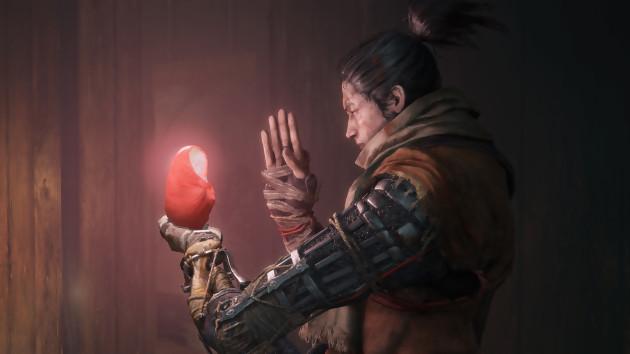 Graphically, the game really looks great and allows you to admire much more colorful environments than what Soulsborne had accustomed us to so far. If the mountain and its snowflakes no longer held any secrets for us since gamescom 2018, we loved scrutinizing the interiors of Château Ashina, just like the flora of Mount Kongo. Determined not to completely turn around, From Software continues to offer darker settings that can make you cloistered, all this supported by an outstanding artistic direction. Special mention to the Hirata estate and its houses crushed by the flames. On the bestiary side, the context means that we often rub shoulders with human beings, but the scenario favors the presence of a few creatures from local folklore that we would not like to come across late at night.
Graphically, the game really looks great and allows you to admire much more colorful environments than what Soulsborne had accustomed us to so far. If the mountain and its snowflakes no longer held any secrets for us since gamescom 2018, we loved scrutinizing the interiors of Château Ashina, just like the flora of Mount Kongo. Determined not to completely turn around, From Software continues to offer darker settings that can make you cloistered, all this supported by an outstanding artistic direction. Special mention to the Hirata estate and its houses crushed by the flames. On the bestiary side, the context means that we often rub shoulders with human beings, but the scenario favors the presence of a few creatures from local folklore that we would not like to come across late at night.


























